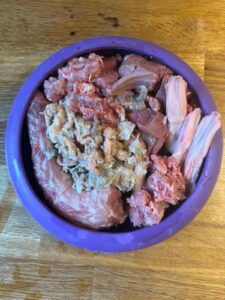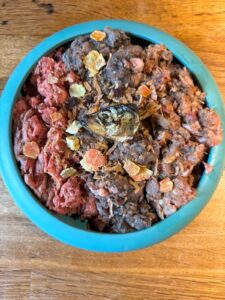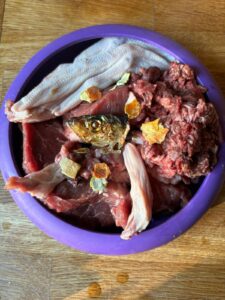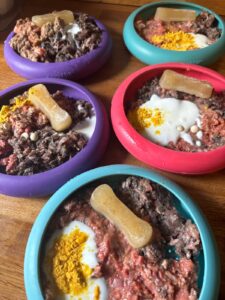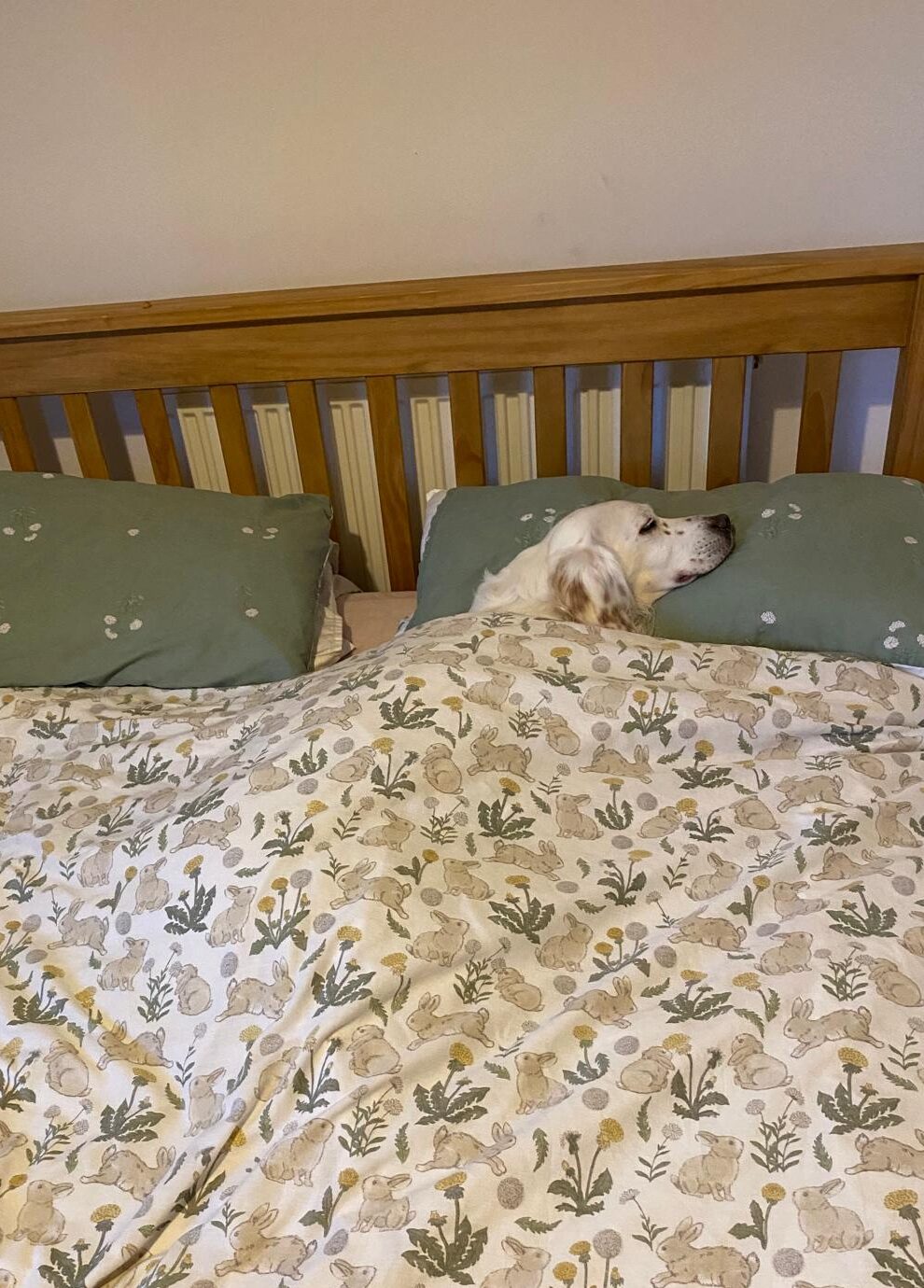Raw food is also known as BARF- Biologically Appropriate Raw Feeding, and it is gaining in popularity, with good reason. Owners who raw feed report a lot of benefits from better skin and coat condition, building muscle, improved dental health and even improvements in behaviour issues.
However it’s really important to get raw feeding right if that’s the diet you choose for your dog. It is not a diet to feed on an adhoc basis or to do on a whim and we advise anyone wanting to raw feed should educate themselves first to ensure their dog gets a healthy, balanced diet without any issues.
Raw feeding isn’t for everyone or every dog, but most people find their dogs adore a raw diet and fussy eaters can no longer wait for dinner time. It isn’t the simplest of diets to manage, but we’ll try and give you some tips on how to get started and where to go for more information.
We’ll cover:
- How to raw feed
- Raw food composition
- Safety
- Brands
- Transitioning
- Dogs with health issues
- Alternatives
- More information
How to raw feed
Modern raw feeders commonly use the 80:10:10 method. This means that the diet comprises of 80% muscle meat, 10% bone and 10% offal which works well for most dogs.
Raw feeding can be split into two categories: completes and DIY.
Completes
Completes are the most convenient way to raw feed – think of it like ready meals but for dogs! These are already balanced to the 80:10:10 ratios meaning that all that needs done is to weigh the correct amount of food out for each dog before feeding.
Pros
- Convenience – ideal for beginners to raw feeding or people who want the benefits in a more convenient way
Cons
- Often more expensive due to the convenience, although prices vary between brands
DIY
DIY feeding means making up the ratios of the raw food which can take a little longer to get your head round, although soon becomes second nature.
Pros
- Great for dogs who require slightly different ratios and for dogs with allergies where it’s important to know exactly what they are getting.
- More budget friendly than completes
- Provides whole bones which are great for healthy teeth and provides natural enrichment and stimulation for dogs
Cons
- Can be trickier to work out and takes experience to get used to the right ratios
Calculating your dogs needs
Calculating how much your dog needs to eat is really simple:
Weight gain= 3% of ideal body weight
Weight maintenance= 2.5% of ideal body weight
Weight loss= 2% of ideal body weight
These percentages are only guidelines, and you may need to change them to suit your dog. Very active dogs or dogs with naturally high metabolisms may need more, whilst some dogs are more prone to weight gain and may need their food reduced.
It’s important to remember that a dog’s need can change through life or even between months. Dogs may need less food as they get older and less active and equally, they may not get as much exercise in winter months and need their food intake reduced to reflect that too.
With a new rescue dog, you may find their requirements are much higher while they build muscle and put weight on, stress also adds to this in the first few months or even as long as 18 months or so until a dog settles and reaches their ideal weight and body condition.
Remember it is important not to just rely on your dogs weight but also to assess your dog’s body composition as discussed in our diet blog.
DIY Feeding Example:
- Dog weight= 20kg, daily food amount = 500g, 250g per meal
- 250g per meal = 200g meat, 25g bone, 25g offal
- Chicken thigh approx. 150g, 15% bone so 22.5g bone, 127.5g meat
- Meal contains 1 chicken thigh, extra 127.5g meat, 25g offal (5% of which should be liver)
Raw food composition
Your dog’s raw food diet comprises of:
- Muscle meat
- Bone
- Offal
- Extras
Muscle meat
80% of your dog’s diet should include muscle meat. It is thought that the more proteins you can feed, the better for your dog to obtain all the vitamins and minerals they need to thrive. Most people feed the usual proteins like chicken, beef, lamb and pork, but there’s lots more variety available such as rabbit, duck & venison to name a few. This is also a great way to manage your dog’s weight, adjusting for more of less fatty proteins appropriately.
Dogs with allergies can also be catered for here too since the diet can be more controlled and novel proteins can be used where needed. Some proteins can be rich and upset tummies so it’s worth making a mental note of which you are feeding in case of any reactions and balancing out with less rich proteins where possible to avoid any issues.
Bones
Bone is an important part of a raw diet. Complete food has 10% bone which works for most dogs but can be too much for some. A dog who is fed too much bone can become constipated or suffer from impacted bone in their intestines, causing a blockage. If your dog is struggling to toilet or their stools are white and powdery, this is an indication of too much bone. These ratios can be adjusted if DIY feeding or if feeding completes, by adding different boneless meat (mince or chunks) to reduce the overall % of bone (note: you may also need to adjust for offal content if diluting with boneless ingredients).
Feeding whole bones is really good for dental health and stimulation. Dogs should be supervised with any bones and should only be given non-weight bearing bones. Any bones that are weight bearing from an animal larger than a bird (such as leg bones) can be too hard and damage teeth. Whole bones will undoubtedly change the balance of your dog’s diet when it comes to the bone element and adjustments should be made to counteract this. Although a diet does not need to be 80:10:10 each day, it should balance on roughly a weekly basis. If DIY feeding, bones can be easily accounted for and sometimes it can be useful to feed a boneless meal after any large bones to balance the diet and ensure the bone content can easily pass. If feeding completes, you should not feed whole bones unless you are happy to dilute completes with boneless content or feed a boneless meal afterwards. Feeding completes on top of whole bones can be risky without making any of the necessary changes.
On a side note, dogs who are raw feed have a naturally lower stomach pH, making it more acidic and allowing them to break down bones more easily, ensuring they pass through better and causing less risks. Dogs who are not fed a raw diet should not be fed whole raw bones.
Offal
Offal is another important part of a raw diet and should account for 10%. Dogs are often driven by texture and some dogs may be put off by the texture of offal. It’s worth playing around with this to see if your dog prefers it in a different form. If you try raw feeding but your dog isn’t keen, it can often be the offal putting them off. Chucks, mince or even flash fried in a frying pan can all help in this department although most dogs will hoover up any raw food with no complaints! Offal intake should include 5% liver.
Extras
Added extras such as eggs and fish provide stacks of nutrients as well as some extra texture. There’s some debate in the raw feeding world as to whether it’s necessary to feed veg or not but it’s certainly not harmful if your dog enjoys it and it can be a good way of filling them up while they’re on a diet too. Probiotics such as kefir can also be added, as well as bone broth, beneficial herbs etc if owners really want to tailor their dog’s diet to see them thrive as much as possible. Some of these can also be frozen and added to meals later which is both convenient and refreshing in summer months.
Safety
Although there’s a lot of scaremongering when it comes to safety with raw feeding, care should absolutely be taken. Simple hygiene should be followed just like preparing meat for humans and it is worth thinking of the logistics of this if you have young children in the house although many people find it easily managed with a family too.
Vets are often not fans of raw food, especially since they see all the times it goes wrong. It’s important to understand what you’re doing if you decide to raw feed so you don’t end up with a dog with impacted bone in their intestine needing an operation or a dog with a cracked tooth from gnawing on a weight bearing bone.
While a lot of the evidence for raw feeding is anecdotal, there are also vets that advocate or support raw feeding and understand that there isn’t the money behind it like the commercial kibble brands have to produce clinical evidence and literature.
Brands
There are many raw feeding brands available, with a brand to suit most budgets.
It is always worth looking into the ethics of brands if this is something that’s important to you, as well as the quality of ingredients. Like with most things, you get what you pay for when it comes to the quality and ethics of meat, there are also brands that are more commercial and overpriced compared to others so although the packaging might look attractive, quality doesn’t always reflect the price.
Here are just some of the brands to consider, mostly tried and tested by our rehoming team, but this is a far from exhaustive list
| Quality | Budget friendly | Ethical |
|
The Dog Butcher Paleo Ridge Manifold Meat Valley (MVM) Naturaw Henley Raw Dog Food Furry Feasts |
Durham Animal Feeds (DAF) Bulmer Totally Natural Southcliffes |
The Dog Butcher Paleo Ridge Manifold Meat Valley (MVM) Naturaw Honey’s |
Transitioning
People transition their dogs onto raw diets in various different ways and there is no right or wrong way to do it, although there are definitely more careful ways to do it.
BARF UK have a comprehensive guide to transitioning here which aims at introducing raw in a very careful and deliberate way to avoid any issues. Many people find that this transition guide is not needed and a straight swap to completes or DIY is successful, however it’s advisable to start with simple, bland proteins such as chicken or turkey (adjusting for any known allergies) and feeding boneless meals before introducing any bones, particularly whole bones.
Whichever way you introduce raw, a straight swap should be done without mixing diets first (i.e mixing existing diet with increasing amount of raw until each meal is solely raw).
Feeding raw and kibble alongside each other can be a controversial subject, with some people believing they should not be fed side by side due to different digestion rates of food.
However, there’s not much evidence surrounding the area and many people do feed kibble in some way whilst raw feeding. It’s generally accepted that raw food and kibble should not be fed in the same meal but using kibble for enrichment activities is acceptable and won’t cause any ill effects. Of course, feeding larger amount of kibble will take away from the assumed benefits of raw and will also affect the pH levels in the stomach which can impact how effectively the dog is able to digest raw and kill off any germs, making raw feeding alongside kibble riskier than fully embracing raw feeding.
Dogs with health issues
Another great thing about raw feeding is that the diet can be tailored to individual dogs. Many people choose to raw feed if their dog has any health issues so they can cater to their needs. This does require some extra research but can really help manage any conditions such as Leish on a low purine diet or changing diet to help arthritic joints. Dogs with allergies are also able to thrive on raw when processed diets that suit them can be difficult to find and it’s worth noting that allergies can differ when proteins are in their raw format too.
Alternatives
Raw feeding isn’t suitable for everyone or for every dog, but thankfully there are lots of high quality commercial foods available now too, including dried versions of raw that have the benefits of raw with the convenience of a kibble.
You can compare commercial brands via All About Dog Food which can be really helpful when selecting a diet and will often help battle the minefield of picking a brand!
Some good quality alternatives that have been personally tried and tasted by our dogs, include:
- Butternut Box
- Eden
- Orijen
- Forthglade
- Gentle
- Pure
- Simply
- Guru
- Wolfworthy
More information
BARF UK have a really helpful Facebook group that we’d recommend to anyone who raw feeds or is interested in learning more about raw feeding their dogs.
All About Dog Food is a really useful website that enables you to compare brands of dog food and rates them in terms of quality of price.


